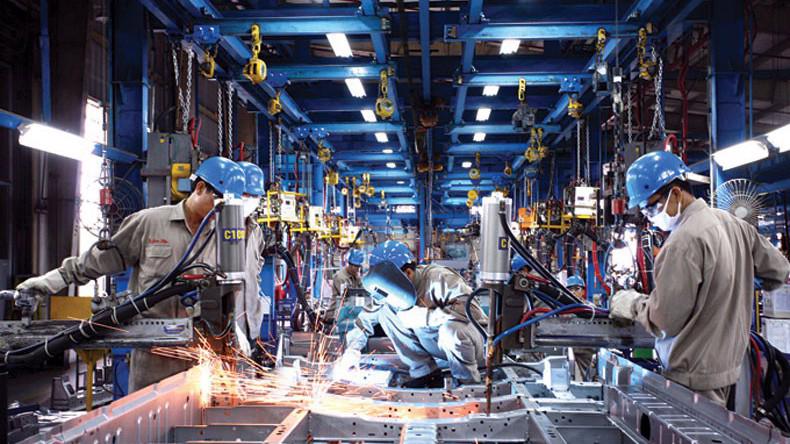Vietnam’s exports based on processing and assembling imported goods have increased significantly in both scale and proportion, from 3 billion USD in 2000 (accounting for 21.44%) to 171.5 billion USD in 2022 (accounting for 48.01%), much higher than competing countries.
Exports based on processing and assembly from imported goods increased very high.
The Ministry of Industry and Trade has just submitted a report to the Prime Minister on the National Program to support small and medium-sized enterprises (SMEs) to participate in the global value chain. Accordingly, the Ministry of Industry and Trade said that since joining the WTO (World Trade Organization – WTO), Vietnam’s trade balance has improved, from a trade deficit of 18 billion USD in 2008 to a continuous trade surplus since 2016 and achieved a double-digit trade surplus for many years, reaching a surprisingly high level in 2022 with over 12 billion USD, in 2023 up to 28 billion USD. Export turnover has increased nearly 6 times, from 63 billion USD in 2008 to 371 billion USD in 2022 (reaching 355 billion USD in 2023).
Joining the WTO in 2007 and signing 17 free trade agreements (FTAs) has made Vietnam one of the economies with a high degree of economic openness (import-export ratio/GDP of approximately 200%), with high and continuous growth in import-export turnover over the years. In just 3 decades, Vietnam has emerged as a world power in manufacturing and exporting. Export growth has basically brought Vietnam to successfully integrate into the global value chain. This has helped Vietnam shift its economic structure and improve national competitiveness.
However, the Ministry of Industry and Trade assessed that although Vietnam has basically successfully integrated into the global value chain, the quality of participation in the global value chain of Vietnam, especially SMEs, is increasingly revealing many limitations. In particular, Vietnam is still positioned in the lowest segment of the global value chain. Notably, the added value associated with export goods originating from Vietnam has not increased in the past decade.
The proportion of added value in Vietnam’s total export value decreased significantly for all sectors, from 69% to only 52% in the period 2000 – 2020. Compared to similar countries, Vietnam is the only country with a significant decrease in the value added content in total export value.
In addition, enterprises operating in Vietnam depend on imports to participate in the global value chain. Currently, Vietnam is importing raw materials, components, machinery and production technology from Asian industries such as China, Korea… and only plays the role of a place to process and assemble final products for export to the final consumer market (usually the US, EU, Japan…).
Exports based on processing and assembling imported goods have increased significantly in both scale and proportion, from 3 billion USD in 2000 (accounting for 21.44%) to 171.5 billion USD in 2022 (accounting for 48.01%), higher than most competing countries. While these countries have continuously decreased over the years (in 2022, this proportion in China was 13.51%; Thailand 28.96%; Singapore 34.25%; Malaysia 26.38%).
There is a specific roadmap to gradually shift the position of the business in the chain.
Statistics show that the number of domestic enterprises, including SMEs, participating in production, export and global value chains is very low, accounting for only 8.2% of the total number of domestic enterprises with a much lower contribution to exports than the foreign-invested sector. The proportion of SMEs playing a role as part of the global value chain is also very low (only about 21% in 2018) and only 14% of enterprises have succeeded in attracting foreign customers or partners.
In addition, because foreign-invested enterprises position Vietnam in low value-added segments (processing, assembly) due to advantages in cheap labor, low production input costs, low import and export taxes (due to signing many FTAs)…; high value-added segments are all located abroad such as upstream stages (research and development, product design: product promotion, distribution, customer care…) and downstream stages (production of raw materials, machinery, equipment, technology) have limited Vietnam’s ability to participate in high value-added production stages.
Therefore, the Ministry of Industry and Trade has proposed to develop a national program to support SMEs to participate in the global value chain. In particular, the orientation focuses on institutionalizing and enhancing the effectiveness of policy implementation to facilitate SMEs to participate and effectively shift to higher value-added segments in the global value chain, towards mastering a value chain in which Vietnam has advantages. Focus on supporting SMEs to improve production and business capacity, effectively connect to domestic supply chains and directly export.
In particular, there is a specific roadmap to gradually transform from processing and assembly enterprises to manufacturing enterprises with original equipment, and manufacturing enterprises with original equipment to develop into manufacturing enterprises with original brands to gradually affirm the position and brand of Vietnamese enterprises and products in the international market.
















